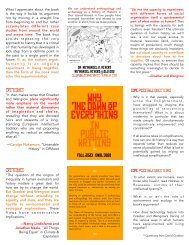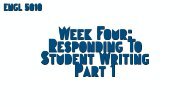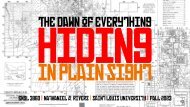Create successful ePaper yourself
Turn your PDF publications into a flip-book with our unique Google optimized e-Paper software.
<strong>ENGL</strong> <strong>5010</strong><br />
<strong>Week</strong> <strong>Four</strong>:<br />
Responding To<br />
Student Writing<br />
Part 2
Haswell 600<br />
In essence they propose commentary that 1)<br />
facilitates rather than judges, 2) emphasizes<br />
performance rather than finished product, 3)<br />
provides double feedback before and after<br />
revision, and 4) helps bridge successful drafts by<br />
requiring immediate revision.
Haswell<br />
604<br />
The best mark is that which allows students<br />
to correct the most on their own with the<br />
least help. An obvious pedagogical truth—<br />
but one that runs counts to the still<br />
established tradition of full correction.
Wilhoit 77<br />
When you read a student’s paper and respond to it as a<br />
reader, you indicate which aspects of the student’s paper<br />
you found interesting, informative, thought-provoking,<br />
humorous, moving, exciting, or boring. When done well and<br />
consistently, this type of response can help your students<br />
form a clearer sense of what it means to write for “real”<br />
readers, not just for teachers who grade their work.
Wilhoit 77<br />
Thinking through the counterpositions<br />
you raise helps students develop their<br />
critical thinking skills and teaches them<br />
how to produce more rhetorically<br />
sophisticated papers.
Wilhoit 81<br />
[T]he tendency of some teachers to “appropriate” their<br />
students” texts. Through their extensive comments,<br />
teachers essentially rewrite the student’s paper—<br />
substituting their thoughts and language for the student's. If<br />
a student incorporates all of these changes when revising,<br />
the final draft would be more the teacher’s than the<br />
student’s.
Wilhoit 86-87<br />
correcting <br />
emoting<br />
describing<br />
suggesting<br />
questioning<br />
reminding<br />
assigning
Wilhoit 90<br />
Do not fall into the trap of believing that students<br />
only learn in class if they have the benefit of your<br />
commentary on their work: they will learn quite a<br />
bit on their own if you design writing assignments<br />
that challenge their thinking or require them to<br />
apply course material in interesting ways.
Wilhoit 101<br />
Teachers who hope to use grades to<br />
motivate students must never sacrifice<br />
the first goal of grading, though: to<br />
provide students an honest, qualitative<br />
assessment of their writing.
Wilhoit 103<br />
Whether you follow your department’s grading standards or develop<br />
standards of your own, your goal is consistency: as you work through a set<br />
of papers, essays receiving the same grade ought to be comparable in<br />
quality. You also want to have clear reasons for the grades you assign. A<br />
grade ought to be based on the quality of a student’s writing and<br />
reasoning. If a student questions a grade, you should be able to point to<br />
specific places in the text where the writing is strong or weak, and you<br />
should be able to explain how those passages helped you determine the<br />
essay’s grade.
Wilhoit 103-04<br />
holistic <br />
atomistic<br />
portfolio
Wilhoit 107-08<br />
An Argument Against Grading
Anson et al 35<br />
Instead, they continue to labor under a trialand-error<br />
model of learning that fails to<br />
engage them fully in the process of critically<br />
considering their structural, rhetorical,<br />
informational, and linguistic choices.
Anson et al 37<br />
Such drafts should represent neither stellar<br />
nor dreadful responses; rather, they should be<br />
“interestingly problematic” in order to<br />
engage students in a discussion of both<br />
obvious and more subtle issues and concerns.
Anson et al 37<br />
[W]hen students analyze sample texts with the goal<br />
of trying to explain, to themselves and others,<br />
what it means to produce such texts<br />
successfully, they are learning skills and strategies<br />
useful in other discursive settings where texts,<br />
and their standards, may be unfamiliar to them.
















